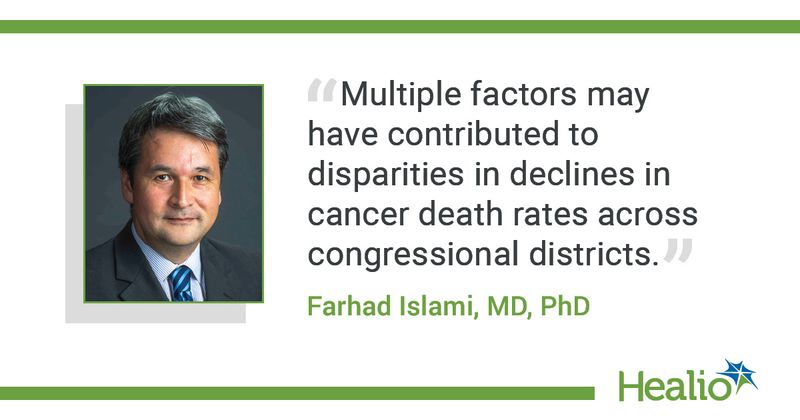Cancer death rates decline across congressional districts, but disparities remain
Cancer death rates decreased overall across congressional districts in the United States over the past 25 years, according to a study published in Cancer.
The analysis revealed a 20% to 45% reduction in mortality among men and a 10% to 40% decline among women in most districts, the society stated in a press release. Districts along the southern coast and border showed the greatest decreases in cancer deaths, with the smallest reductions seen in the Midwest and central areas of the South, including Appalachia.

However, the study also showed race- and gender-based disparities in cancer mortality rates.
“While the decline in death rates from cancer was most pronounced for Black men, overall cancer mortality remains substantially higher among Black people compared [with] other populations,” lead author Farhad Islami, MD, PhD, senior scientific director of cancer disparity research at American Cancer Society, said in the press release. “We also found the number of districts with the greatest relative declines in overall cancer death rates was larger among Hispanic people than white people. But paradoxically, Hispanic people also had the largest number of districts with no or smallest relative declines in rates.”
Researchers collected county-level mortality rates and population data from National Center for Health Statistics to estimate relative change in U.S. age-standardized cancer mortality from 1996-2003 to 2012-2020. They estimated this relative change by sex and congressional district. The analysis looked at four most common causes of cancer deaths and also evaluated mortality rates by race/ethnicity.
Results showed the following:
- Men had the largest decrease in lung cancer mortality across all congressional districts, with reductions ranging from 21% to 72% since 1996. Researchers noted the smallest decreases in both sexes among districts in the Midwest and South, which have more lax tobacco control policies. Additionally, although previous data indicated that rates of women’s deaths due to lung cancer to be more evenly distributed throughout the U.S., the highest rates of lung cancer deaths in both sexes now occur in the Midwest and South.
- Districts with the highest colorectal cancer death rates historically have been scattered throughout the Northeast, South and lower Midwest. However, the highest colorectal cancer death rates are now in the areas surrounding the Mississippi River Valley in the South and Appalachia.
- Female breast cancer mortality rates have declined across the country by 13.6% to 57.7%. The greatest reductions occurred in congressional districts that previously had the highest death rates, including those along the East Coast and southern U.S. border. Today, the districts with the highest death rates are clustered in the South and West.
- The greatest reduction in prostate cancer death rates also occurred in districts that previously had the highest mortality rates, specifically those along the East Coast and in the South. Relative declines across the country ranged from 25% to more than 68% in some congressional districts. The highest death rates currently are in the South and West.
Islami said multiple factors may account for the disparities in cancer death rate reductions across congressional districts. These include differences in the availability of public health policies for tobacco control and access to care.
“Elected representatives could help further advance progress against cancer mortality and reduce cancer disparities in their districts, state and nationality by supporting broad and equitable implementation of effective interventions to reduce cancer risk factors and improve cancer screening and treatment,” Islami said in the press release.
References :
- American Cancer Society. First study of trends in cancer death rates by congressional district shows overall declines; regional, ethnic and racial disparities persist (press release). Available at: https://pressroom.cancer.org/releases?item=1215. Published May 8, 2023. Accessed May 8, 2023.
- Islami F, et al. Cancer. 2023;doi:10.1002/cncr.34808.

